We had a little bit at first.
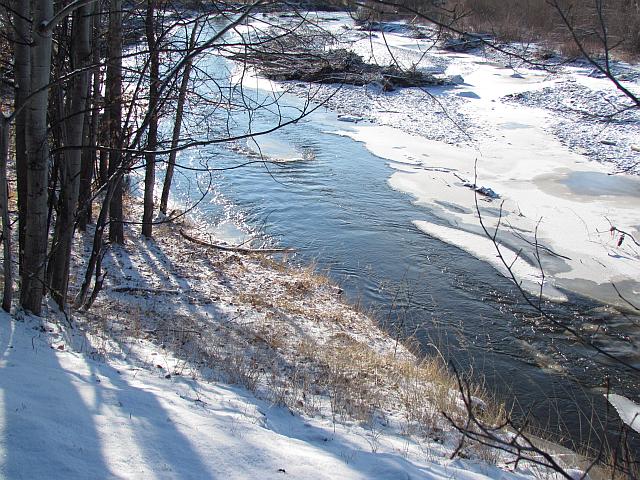 The McClinchy river is quite low now. The flow is restricted in the high country where everything is frozen so not much water gets to lower elevations.
The McClinchy river is quite low now. The flow is restricted in the high country where everything is frozen so not much water gets to lower elevations.
We had one very pretty day, then it got cold. The temperature never got below -18C, which is not at all cold for here, but these fronts pack a nip far below the given temperature, even when there is no wind. I have no idea why that should be so. Day temperatures never exceeded – 12C.
I was glad of the stone stove that I built with Mogens last spring. (Check out the posts itemized under the category “building a stone oven” on the side bar at the right.)
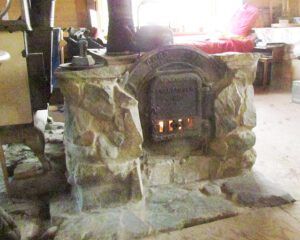 Because of the chimney configuration it tends to smoke when the door is open, but otherwise it burns fine. I use the cookstove in the morning for a faster fire, but that does not hold the heat. So about an hour before sundown, I light the stone stove – by the time the sun has gone, the rocks are radiating heat nicely. I cook supper on it, then give it a last feed before bed, and the cabin is toasty all night and still warm in the morning.
Because of the chimney configuration it tends to smoke when the door is open, but otherwise it burns fine. I use the cookstove in the morning for a faster fire, but that does not hold the heat. So about an hour before sundown, I light the stone stove – by the time the sun has gone, the rocks are radiating heat nicely. I cook supper on it, then give it a last feed before bed, and the cabin is toasty all night and still warm in the morning.
The birds, who had been mostly ignoring the feeder, suddenly flocked to my offerings. Most common were the mountain and black-capped chickadees.
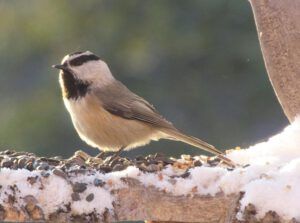
I was most surprised to see a couple of starlings. They are the only alien birds that visit here; they usually pass through for a couple of days in the spring. They are among a list of British birds found in Shakespeare that were introduced to New York by some misguided philanthropist. They are not designed for colder climates. These two were definitely out of their element.
 As it finally warmed up, it snowed in earnest, and we had about 6″.
As it finally warmed up, it snowed in earnest, and we had about 6″.
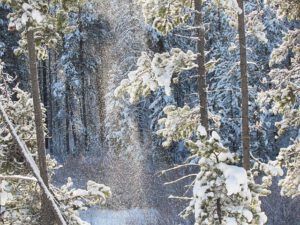 Three grey jays, also known as camp robbers and whiskeyjacks, usurped the feeder.
Three grey jays, also known as camp robbers and whiskeyjacks, usurped the feeder.
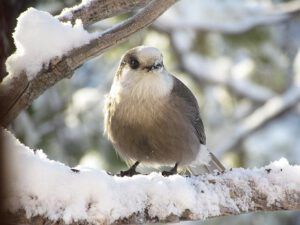 The sun came out, and the snow became magical before it all got melted and blown off the trees.
The sun came out, and the snow became magical before it all got melted and blown off the trees.
 It is supposed to snow a bit more before the weekend, but I hope not too much, for I wish to have a booth at the Tatla Lake Christmas craft fair. It is also supposed to thaw so I expect I will be able to drive out without having to have the road ploughed.
It is supposed to snow a bit more before the weekend, but I hope not too much, for I wish to have a booth at the Tatla Lake Christmas craft fair. It is also supposed to thaw so I expect I will be able to drive out without having to have the road ploughed.

You mention the three Grey jays visiting your feeder. I too have three that visit mine. While researching , I found the following and thought it interesting regarding the significance of these trios. But, perhaps you were already aware?
When young Gray Jays leave the nest in late April, they huddle together for warmth at first and later gradually start moving through the forest as part of a cohesive family group. Then, when they are about 55 days old (five weeks out of the nest) they start to fight among themselves and within ten days, one of them has expelled its siblings from the natal territory. The dominant juvenile will continue to accompany its parents through the first fall and winter (and sometimes longer), benefiting from their experience and protection. The expelled siblings sometimes succeed in finding an unsuccessful pair that will tolerate them but most fail to do so and about 80% of them are dead by fall (as opposed to just 50% of the dominant juveniles that have stayed at home with their parents). Since siblings share 50% of their genes (as many as a parent shares with its offspring) an explanation is required for any behaviour in an individual that results in a high death rate in that individual’s brothers and sisters.
while the stone oven is burning… could the stovepipe be drawing some air from the wood stove as well?… hence the smoke billows when the of the stone oven door is opened? perhaps adding a flue damper to the wood stove pipe, below the stove pipe connections would help?